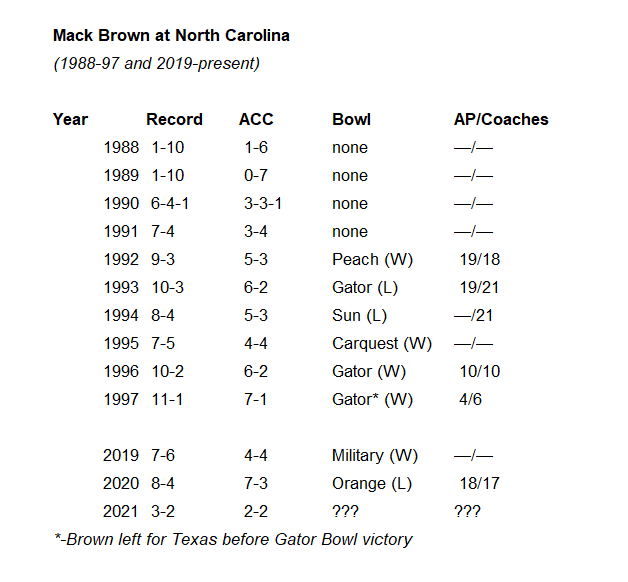
As With Mack Brown’s First UNC Tenure, Third Season Carries Critical Meaning
By David Glenn
In the summer of 1990, the Mack Brown jokes were everywhere in Chapel Hill, and they weren’t flattering.
Brown, then only 38 years old, had completed two seasons as the head coach at UNC, and they were both absolutely brutal. The Tar Heels finished 1-10 in 1988, then 1-10 again in 1989.
In 1989, five of their seven ACC losses were blowouts: 40-6 at NC State, 50-17 at Virginia, 38-0 at Maryland, 35-3 against Clemson, and 41-0 versus Duke. After the latter game, the regular-season finale, the Blue Devils of coach Steve Spurrier famously posed for a photo in front of the Kenan Stadium scoreboard. Ouch.
Obviously, Carolina football had hit rock bottom. What was harder to know at the time was what would come next. Brown incessantly talked about recruiting, and he even received some glistening “that guy could sell ice to Eskimos” reviews from those who wrote about the top high school football prospects, but plenty of skeptics remained.
Some of the spicy jokes from 1990 can’t be repeated 31 years later, but a few had a more innocent, Andy Griffith-type vibe. “Did you hear about the fan who left his four UNC football tickets visible on his dashboard while parked on Franklin Street? … When he returned to his car, his windshield had been smashed. The thief took everything of value, but now there were eight tickets on the dashboard.”
As it turned out, of course, Brown actually was recruiting well at the end of the 1980s, despite the truly embarrassing product on the field. Wide receiver Bucky Brooks, safety Rondell Jones and cornerback Thomas Smith were among those who made their UNC debuts in 1989. Wide receiver Corey Holliday, running back Natrone Means, linebacker Tommy Thigpen and other key players entered the fray in 1990.
With the perception of his program hanging in the balance, Brown went from two straight losing seasons to eight consecutive winning campaigns. By 1996 and 1997 (see chart), he had built two of the best teams in program history.
Now 70, and in the midst of Year Three of his second tenure with the Tar Heels, Brown has a different kind of challenge on his hands, but it also represents an important fork in the road.
If the Tar Heels are going to be a regular in the national Top 25, as they were in the latter part of Brown’s first tenure in Chapel Hill, and as Texas certainly was (13 times in 16 seasons in the final polls) on his watch, they can’t afford to fall short of that threshold here in 2021. As in 1990, Brown’s recruiting pitch would lose a lot of credibility without obvious signs of upward mobility on the field.
Junior Sam Howell, arguably the best NFL quarterback prospect ever produced by the Tar Heels, almost certainly is playing his final season in Chapel Hill. (He’s projected as a first-round draft pick in 2022.) There is enough talent on the roster to compete with anyone in the ACC, as the Heels showed in their dominating home victories over Virginia and Duke and even their season-opening loss at Virginia Tech.
Publicly and privately, Brown has been pointing to this season as a potential breakthrough for two years running. The dream-season scenario likely died with UNC’s 45-22 faceplant at Georgia Tech, but other positive things remain within reach, including a second straight finish in the Top 25.
Keeping that dream (and others) alive absolutely requires Carolina victories in its next two games. Both are at Kenan Stadium, where the Tar Heels appear far more confident and comfortable than they do on the road. The opponents are Florida State and Miami, which would have been a daunting doubleheader years ago, but the current versions of the Seminoles (1-4) and Hurricanes (2-3) will arrive in Chapel Hill with losing records.
With wins over FSU and UM, the Heels would be 5-2 overall, 4-2 in ACC play, with an open week to prepare for the assumedly more difficult games awaiting at the end of October (at Notre Dame) and in November (a non-conference home game against Wake Forest, at Pitt, at NC State).
Who knows what dreams might still be alive then?
Without that two-game sweep, though, it’s hard to imagine a scenario in which Brown’s “Year Three” will symbolize the upward arc of the UNC program, as it clearly did, on the way to much bigger things, in 1990.
 David Glenn (DavidGlennShow.com, @DavidGlennShow) is an award-winning author, broadcaster, editor, entrepreneur, publisher, speaker, writer and university lecturer (now at UNC Wilmington) who has covered sports in North Carolina since 1987.
David Glenn (DavidGlennShow.com, @DavidGlennShow) is an award-winning author, broadcaster, editor, entrepreneur, publisher, speaker, writer and university lecturer (now at UNC Wilmington) who has covered sports in North Carolina since 1987.
The founding editor and long-time owner of the ACC Sports Journal and ACCSports.com, he also has contributed to the Durham Herald-Sun, ESPN Radio, the New York Times, the Washington Post, Raycom Sports, SiriusXM and most recently The Athletic. From 1999-2020, he also hosted the David Glenn Show, which became the largest sports radio program in the history of the Carolinas, syndicated in more than 300 North Carolina cities and towns, plus parts of South Carolina and Virginia.
Chapelboro.com does not charge subscription fees. You can support local journalism and our mission to serve the community. Contribute today – every single dollar matters.


